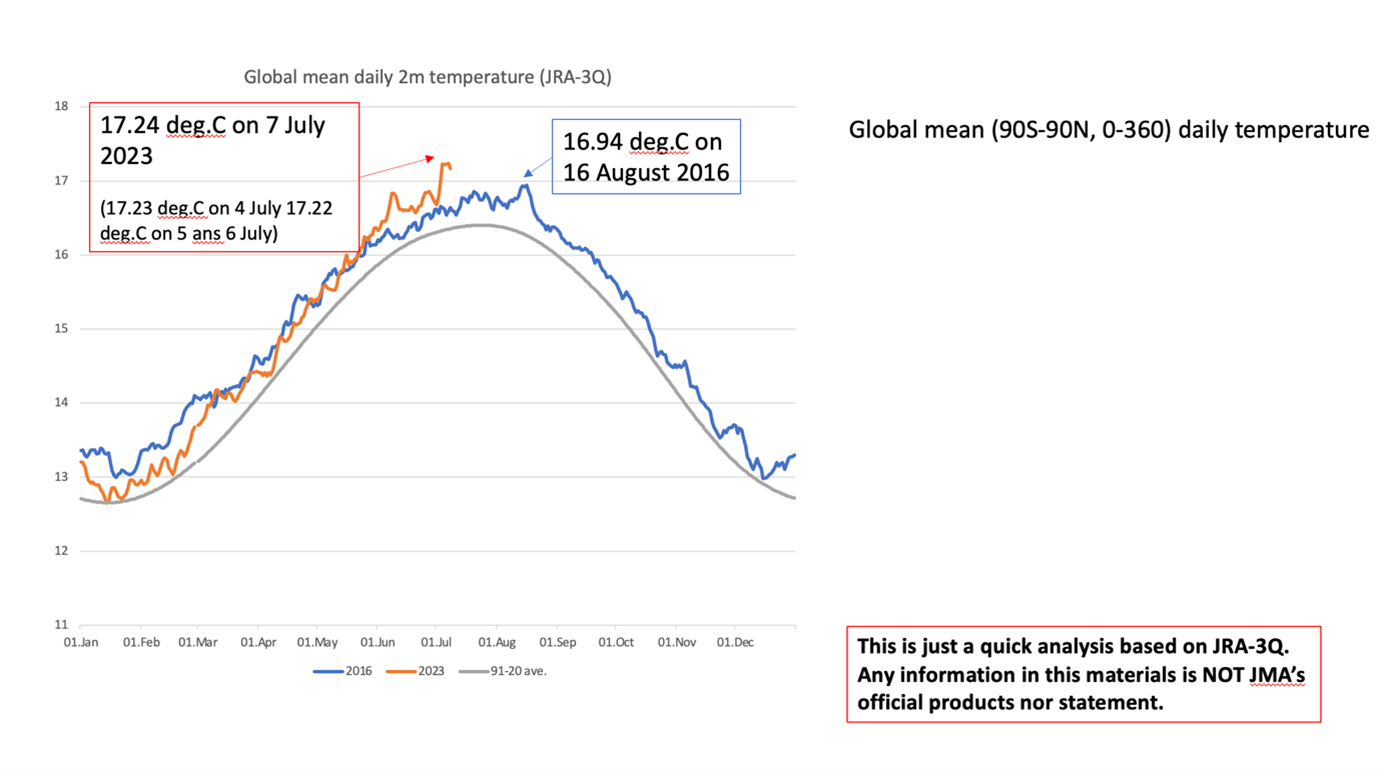The preliminary data confirm the satellite observations: Last week was the hottest ever recorded on the planet, continuing the trend set the previous month. June 2023 was also the hottest June on record. Sea surface temperatures were the highest ever recorded, and Antarctic sea ice was at its lowest ever extent.
The incredible temperatures are showing just how much humans have impacted the climate. Japanese reanalysis data is yet to be confirmed, but it is consistent with the European Copernicus satellite data that people have been discussing over the last week. For this reason, the World Meteorological Organization (WMO) has shared the data.
“This is worrying news for the planet.”
Prof. Christopher Hewitt
It shows that the average global temperature on July 7, when the temperature peaked after many days of record-breaking temperatures, was 17.24 °C (63.03 °F). Before last week, the record for hottest temperatures was registered on August 16, 2016, at 16.94 °C (62.49 °F). 2016 was a strong El Niño year – but in 2023, El Niño is only just getting started. Which is troubling.
“The exceptional warmth in June and at the start of July occurred at the onset of the development of El Niño, which is expected to further fuel the heat both on land and in the oceans and lead to more extreme temperatures and marine heatwaves,” Professor Christopher Hewitt, WMO Director of Climate Services, said in a statement.
“We are in uncharted territory and we can expect more records to fall as El Niño develops further and these impacts will extend into 2024,” Professor Hewitt continued. “This is worrying news for the planet.”
Comparison between the preliminary 2023 data and the 2016 data.
Image Credit: WMO
The reason why the data is considered preliminary is due to the fact that official values are compiled by combining multiple data sets, from land stations, ships, and satellites, as well as models that can fill in the gaps where measurements are not taken. Given the unprecedented nature of these measurements and how they all paint the same dramatic picture, the WMO has decided to share them as it produces the official values.
The unfolding climate crisis and the increase in global temperature average don’t mean that all places are much hotter all the time. The record-breaking June showed a much hotter Africa, Canada, and Europe, but unseasonably cooler temperatures in the United States, Western Australia, part of Brazil, and Russia. The ocean temperatures are also of great concern, as the North Atlantic experienced temperatures higher than what the models had predicted.
“The North Atlantic is one of the key drivers of extreme weather. With the warming of the Atlantic there is an increasing likelihood of more hurricanes and tropical cyclones. North Atlantic sea surface temperature is associated with heavy rain or drought in West Africa,” added Dr Omar Baddour, chief of climate monitoring at WMO.
The ice extent in Antarctica has also been dramatically lower than expectations, with 2.6 million square kilometers of loss compared to the long-term average and 1.2 million square kilometers (463,323 square miles) of loss compared to the previous record set in 2022. That’s about one-eighth of the area of the United States.
The WMO also highlights the dramatic hydrogeological changes, with many areas of the world experiencing unexpected droughts while others are facing torrential rains and floods. A meter of rain has fallen in Mumbai, India in just a fortnight.
The climate crisis will continue to change the planet, but bold action taken today will avoid the most catastrophic consequences for humanity and the other living creatures we share this world with.
Source Link: First Week Of July Was The Hottest On Record And El Niño Will Make This Worse
